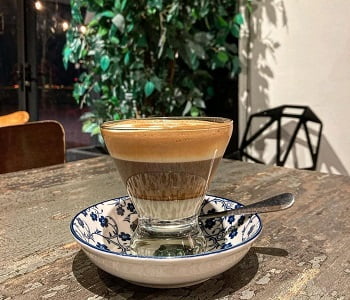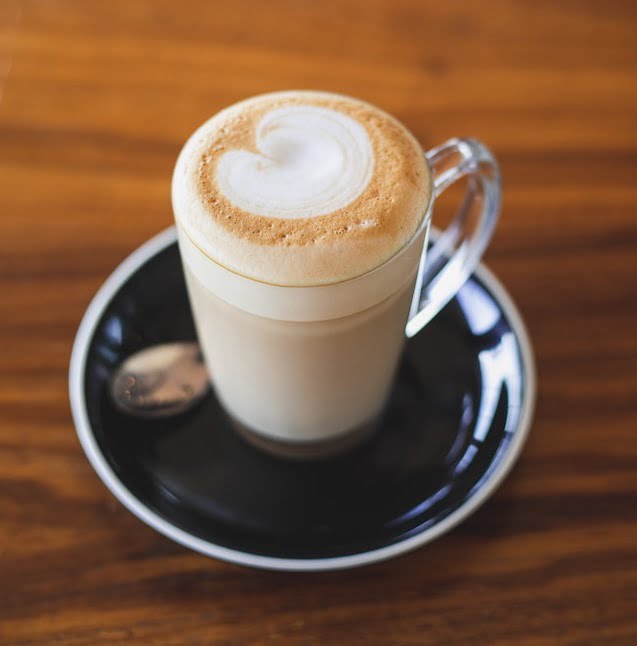A Spanish Latte is a rich, creamy espresso-based drink that combines bold coffee flavors with the sweetness of condensed milk. This creamy beverage puts a unique twist on the classic café con leche, offering a perfect balance of strong and sweet.
From cafes in Europe to trendy coffee shops in the U.S., the Spanish Latte is becoming a favorite for those who want more than just a regular latte—it’s coffee with character.

As an Amazon Associate, I earn commission from qualifying purchases.
What is a Spanish Latte?
A Spanish Latte is a coffee drink that is made with espresso, scalded milk, and sweetened condensed milk. It’s typically sweeter than a regular latte due to the condensed milk, which adds a rich, creamy flavor.
Spanish Latte originated in Spain but has gained popularity in other parts of the world, especially in Southeast Asian and Arab countries. It can be served hot or cold, often with a layer of foam on top.
How to Make a Spanish Latte?
Here’s the Best Spanish Latte recipe you can easily make at home. You’ll enjoy a rich, creamy, and perfectly sweetened cup of coffee with just a few simple steps.
What you’ll need to make Spanish Latte
Ingredients:
Double shot Espresso (60 mL): Use dark roast beans for a strong and rich coffee base.
Sweetened Condensed Milk (2 tablespoons): A thick, sweetened milk product that adds creaminess and sweetness to the latte. Use 1 tablespoon for mild sweet and 2 tablespoons for a full sweet drink.
Milk (120 mL): The Authentic Recipe uses Whole milk for its rich texture, but you can use 2%, skim, or non-dairy alternatives like oat, almond, or soy milk.
Ice Cubes: For the Iced version
Equipment:
Espresso Machine: Spanish Latte is prepared with rich and concentrated Espresso shots made using traditional Espresso machines. If you don’t have one, you can use a Moka pot or AeroPress as alternatives. They will result in a slightly lighter but still rich brew.
Milk Frother or Whisk: Unlike a traditional latte, a Spanish Latte doesn’t typically have a foam layer, but you can create a thin foam using a Milk frother or whisk.
Step by Step Instructions
1- Prepare the Base:
Prepare a double shot of espresso (60 mL) using your espresso machine. Pour 2 tablespoons of sweetened condensed milk into a glass or mug. Add the hot espresso on top of it and stir well to combine. This creates the sweet and strong base of your Spanish Latte.
2- Scald the Milk: Pour 120 mL of your chosen milk into a small saucepan. Heat the milk over medium heat, stirring constantly, until it reaches about 180°F (82°C) or just before it starts to simmer. You’ll see small bubbles forming around the edges of the pan. Remove from heat immediately to prevent boiling. Scalding the milk gives the latte a distinct flavor and smoother texture.
3- Combine and Serve: Slowly pour the scalded milk over the espresso-condensed milk mixture. You can create a thin foam layer by whisking the milk vigorously or using a milk frother before pouring if desired.
4- Optional Finishing Touches: Adjust sweetness by adding more condensed milk if desired. For extra flavor, sprinkle cinnamon, cocoa powder, or grated chocolate on top.

Make Iced Spanish Latte
At many cafes and coffee shops, the Spanish Latte is most popular as an iced drink, blending the bold espresso with sweetened milk over ice.
For an iced Spanish Latte, brew your espresso and let it cool slightly before mixing with sweetened condensed milk. Pour this mixture over a glass filled with ice and chilled frothed milk. I like to use frozen coffee cubes instead of regular ones for a stronger taste. You can sprinkle cinnamon or cocoa powder on top for an aromatic twist.

Some Expert Tips for Spanish Latte
What Flavorings can you add to Spanish latte?
You can add flavorings like a dash of vanilla extract, a dusting of cocoa powder, a sprinkle of cinnamon, or a pump of caramel sauce to enhance the sweetness of a Spanish Latte. Personally, I love adding cinnamon for a sweet and aromatic touch.
Make Dairy-Free Spanish Latte
For a dairy-free Spanish Latte, replace regular milk with plant-based alternatives. Oat milk is a popular choice because it froths nicely and has a creamy texture. Almond milk offers a nutty flavor, while soy milk provides a protein-rich option that steams nicely. For the condensed milk component, use sweetened coconut condensed milk or make your own by reducing plant-based milk with sugar. I like using oat milk for its rich, creamy consistency that mimics whole milk closely.
What Coffee Beans are Best for Spanish Latte?
Dark roast coffee beans are best for Spanish Latte, as they provide a strong, bold flavor that stands up well to the sweetness of condensed milk. Look for beans with chocolatey, nutty, or caramel notes to complement the drink’s richness.
I Like Lavazza Espresso Intenso Dark Roast; it’s perfectly rich and strong.
Spanish Latte vs Regular Latte
The main difference between Spanish Latte and Regular Latte is sweetness. Spanish Lattes use condensed milk, making them significantly sweeter than regular lattes, which are typically unsweetened or only lightly sweetened with optional syrup or sugar.
Another difference is in the preparation of the milk. For a Spanish Latte, scalded milk is used, which makes the texture of the drink creamier and smoother. On the other hand, a regular latte uses frothed milk, which is lighter and creates a more airy texture.
Also, Spanish Lattes are often served in smaller portions, while Lattes have a higher milk-to-espresso ratio, making them a more diluted and milky drink overall.

Spanish Latte vs Vietnamese Coffee
Spanish Latte and Vietnamese coffee are kinda similar because they both use strong coffee and sweetened condensed milk, but they’re also different in a few ways.
The main difference is Spanish Latte typically uses Arabica beans with intense espresso as a base, while Vietnamese coffee is made with Robusta beans brewed through a Phin filter. The milk ratio also varies, with Spanish Latte including regular milk, whereas Vietnamese coffee relies solely on condensed milk.

How to Order Spanish Latte in Starbucks
Starbucks does not offer Spanish Latte as a standard menu item. You can order Cafe Misto which is a similar drink prepared with equal amounts of coffee and milk or you can order a customized Latte. Request the barista to add white chocolate mocha sauce to your Latte. This will provide sweetness similar to condensed milk, though it won’t be exactly the same.
How many calories does the Spanish latte have?
A typical serving of Spanish Latte contains approximately 250-300 calories, though this can vary depending on the specific ingredients and proportions used. The calorie content primarily comes from condensed milk (about 60 calories per tablespoon) and whole milk (around 60 calories in 100 mL). The espresso itself contributes minimal calories.
For a lower-calorie version, you can adjust the amount of condensed milk or opt for non-dairy milk alternatives, which typically have fewer calories than whole milk.
Read about other coffee drinks:
Spanish Latte Recipe
Equipment
- Espresso machine
- Milk Frother or Whisk
Ingredients
- 2 shot Espresso
- 2 tbsp Sweetened Condensed Milk
- 120 mL Whole Milk
- Ice Cubes (for iced version)
Instructions
- Prepare the Base: Brew a double shot of espresso (60 mL) and mix it with 2 tablespoons of condensed milk in a glass or mug.
- Scald the Milk: Heat 120 mL of milk in a saucepan to about 180°F (82°C), just before it start boiling.
- Combine and Serve: Slowly pour the scalded milk over the espresso-condensed milk mixture. Optionally, create a thin foam layer with a whisk or frother.
- Finishing Touches: Adjust sweetness if needed and add optional toppings like cinnamon or cocoa powder.
- For Iced Spanish Latte: After brewing, allow the espresso to cool slightly and mix it with the condensed milk. Pour this mixture over a glass filled with ice and chilled frothed milk.




